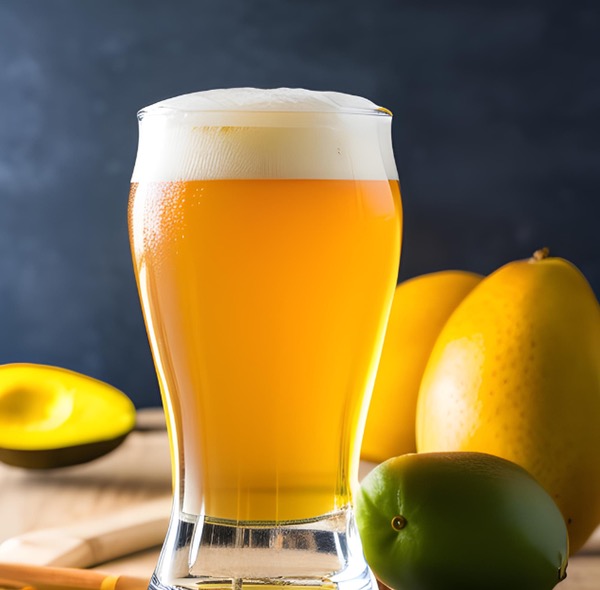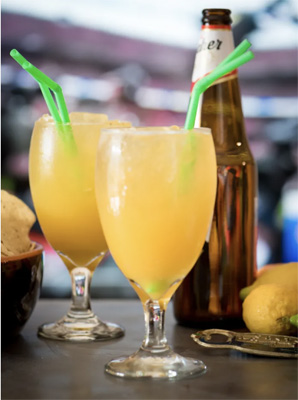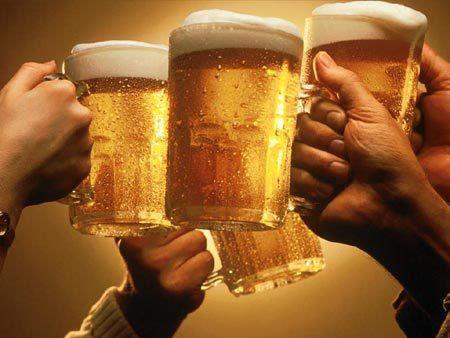NEW! We now have Mexican Cerveza style beer available!
Contact us for all details.

NEW! We now have Mexican Cerveza style beer available!
Contact us for all details.


NEW THIS SUMMER!
Mango Wheat Beer
This delicious new beer is full of flavour and refreshment!
Pure mango puree provides just the right amount of fresh mango flavour, complemented by the subtle fruitiness and hazy appearance a wheat beer. It’s topped off by a beautiful snow-white head.
4% alc
$75 per 20L
Contact us to reserve yours!
cheers@glasshalffull.ca

Sounds funny, but this beverage is so refreshing and thirst-quenching! Just what you all need to sip on while you’re rooting for your favourite team!
This is the perfect cocktail for fancy beer drinking. Start with a little rum, add some fresh citrus juices and simple syrup. Then top it all off with ice cold beer. Stick a straw in it and you are good to go!
Try this cocktail with lemon juice and also with lime juice. Both are very good — the lime is a bit sweeter.
INGREDIENTS
INSTRUCTIONS
Fill a 16 ounce glass with ice
Add rum, simple syrup*, lemon and orange juices
Top with beer
To make simple syrup, heat equal parts sugar and water in saucepan over medium high heat. Whisk until sugar has dissolved. Continue cooking for a couple more minutes. Cool. Store in covered container in refrigerator for up to 2 weeks.
Original article from: www.therecipewench.com

Question
Whats the difference between a lager and an ale?
Answer
Ales are fermented using a top-fermenting yeast. They are fermented at warmer temperatures and are usually more full bodied beers.
Lagers use bottom fermenting yeast and ferment at cooler temperatures over a longer period of time. Lagers are usually lighter bodied and more refreshing.
What are Hops?
Hops (Humulus lupulus) are a perennial plant of the Cannabaceae
family that also includes the genus Cannabis. In beer hops provide
bitterness to balance the sweetness of malt sugars, as well as flavors,
aromas, resins that increase head retention, and antiseptics to retard
spoilage. Often referred to as a “vine”, hops are actually a “bine”,
using a strong stem and stiff hairs to climb rather than tendrils and
suckers to attach. It is the flower of the hop plant that is used in
brewing. Hop flowers or cones resemble pine cones b ut are composed
ut are composed
of thin, green, papery, leaf-like bracts. At the base of these bracts are
waxy, yellow lupulin glands that contain alpha acids responsible for
bitterness and essential oils that give beer flavor and aroma. The plant
has separate male and female bines, but only the female bines develop
cones. If male plants are allowed to pollinate them, the flowers will produce seeds,
rendering them useless for brewing. Aside from their use in beer, hops also have medicinal application as a sleep aid. Hop filled pillows were once a common remedy for insomnia.
Day length during the growing season has a major effect on yield. For this reason the
majority of the world’s commercial hop production occurs between latitudes 35° and 55°,
either north or south of the equator. The largest producers of hops
are Germany, the United States, China, and the Czech Republic.
Other important growing regions include England, New Zealand,
and increasingly Argentina. Climate and soil conditions have a
major effect on hops. Varieties developed in one region will have
different flavor and aroma profiles when grown in another.
Hop plants sprout in the spring and die back to a cold-hardy
rhizome in the fall. During peak growing season they grow very
rapidly, up to twenty inches per week. Commercial hop growers
cultivate hop bines on V-shaped, wire and twine trellises that are
up to twenty feet tall. In spring, at the start of the growing season,
two to three young shoots are trained in a clockwise direction
around each horizontal length of twine. The harvest season begins
in August and continues into October with different varieties of
hops coming ready at different times. Harvesting machines cut the
bines and twine at the top and bottom and load them onto trucks.
They then pass through a series of sorters to separate the cones from the stems and
leaves. The cones are placed in a kiln where 140° air is circulated, drying the cones to
about 30% of their green weight. After cooling the cones are compressed into bales or
further processed into pellets or extracts.
Types of Hops for Brewing
Hops are available to brewers in whole-leaf, pellet, or extract form. American craft brewers
have also started using fresh, unprocessed hops to brew “harvest” or “fresh-hop” ales.
Each of these forms has advantages and disadvantages.
• Whole-leaf Hops – Whole-leaf hops are simply the dried hop
cones that have been compressed into bales. They are
believed to have greater aromatic qualities than the other
forms and are easier to strain from wort. However, because
they retain more of the vegetative matter greater volumes
must be used. They soak up more wort than other forms
resulting in greater loss to the brewer. Their bulk also makes
them more difficult to store and more susceptible to spoilage.
Hops can be generally divided into two broad categories, bittering and aroma. Those hop
varieties that contain high levels of alpha acids are called bittering hops because a lower
volume is needed to achieve high levels of bitterness. Those with lower alpha acid content
but higher levels of essential oils are called aroma hops. Beyond this broad division,
general characterizations can be made based on the traditional area of origin.
• Continental or Noble Hops – The noble hops originate in central Europe and are among
the most prized of the aroma hops. There are four noble hops, Hallertau, Tettnang,
Spalt, and Czech Saaz. These hops impart a smooth bitterness and spicy/floral aromas.
The noble hops are often used in lagers. Common descriptors for these hops include
spicy, black pepper, licorice, perfume, floral, and herbal.
• English Hops – The most traditional English hop varieties fall into the low alpha acid
aroma hop category. The most common are East Kent Goldings and Fuggle. Other
higher alpha English hop varieties include Challenger, Target, and Progress. Common
descriptors for the English hops include herbal, grassy, earthy, floral, and fruity.
• American Hops – Bright, fruity, and resinous, these are the signature hops of American
pale ale and IPA. The United States grows a number of hop varieties that can be
considered duel use hops, with high alpha acid content and pleasant aromatic qualities.
Commonly used American hop varieties are Cascade, Centennial, Chinook, Willamette,
and Amarillo. Common descriptors for the American hop varieties are citrus, grapefruit,
resinous, piney, fruity, and spicy.
Hops in the Brewing Process
Brewers use hops primarily to get bitterness, flavor, and aroma. Hops can be added at
several points in the brewing process to enhance one or the other of those things. While
most hops are added in the boil kettle, they can be added a various stages prior to and
after the boil as well.
• Kettle Hops – Kettle hops is the name given to those hops added to the kettle during
the boil. These include early addition hops for bitterness and late addition hops for
flavor and aroma.
• Bittering Hops – Bitterness from hops comes
from alpha acids found in the lupulin glands of
the hop flowers. The main alpha acids are
humulone and cohumulone and adhumulone. In
order to become bitter these acids must be
chemically altered, isomerized, by boiling.
Isomerization is a chemical process in which a
compound is changed into another form with the
same chemical composition but a different
structure. The percentage of the potential alpha
acid that is isomerized is referred to as
utilization. Because the length of the boil determines degree of utilization,
bittering hops are usually added at the beginning of the boil or with at least 60-
minutes of boiling time remaining.
• Flavor Hops – Hop flavor and aroma are derived from essential oils found in the
lupulin glands. These oils include humulene, myrcene, geraniol, and limonene,
among others. The flavors are released as these oils become dissolved into the
wort during the boil. However, these oils are highly volatile and are to a large
degree lost to evaporation. For this reason flavor hops are added with twenty to
forty minutes remaining in the boil. This provides a compromise between
isomerization of the alpha acids and loss of essential oils.
• Aroma Hops – Because the aromatic essential oils are highly volatile, aroma
hops are added in the last minutes of the boil to minimize their loss to
evaporation.
article written by Michael
 Portable Draught Beer System (also known as Jockey box)
Portable Draught Beer System (also known as Jockey box)
What are they and how do they work?
A jockey box system can sometimes be called a coil box or cold plate box. The name Jockey stems from the portability of the unit as it is easy to move from one location to another (jockey around).
A Jockey Box system contains all the equipment necessary to dispense beer; cooler box, beer line – stainless steel coils or cold plates, shank, faucet, CO² regulator, CO² tank and beer line connectors, and some come equipped with a drain tray and cup holder. CO ² gas is used to pressurized the keg for dispensing.
The key to the Jockey Box dispensing cold beer is the coil or cold plate unit that acts like a flash chiller meaning that the stainless steel beer line coil or aluminum cold plate (stainless steel line is encapsulated) is refrigerated using an ice water bath in the case of the coil system or ice only with the cold plate.
The Jockey Box system works on the principles that the keg is sitting at room temperature, 70º F and when the beer passes through the coil or cold plate located in the cooler box the beer temperature will drop to the ideal dispensing temperature of 38º F. It is the perfect system for large parties or special events such as a family reunion or company picnic. As it does not require electric it can be set up anywhere. CO ² gas is used to pressurized the keg for dispensing.
Keeping the keg cool is important to the function of the Jockey Box system and that is why it is recommended that keg jackets be used to ensure cold beer. Kegs when used with a Jockey Box system should never be stored in direct sunlight and in the heat of the summer it is wise to place the keg in an ice water bath in a tub. This way, the beer in the keg stays cold and the performance of the Jockey Box remains optimum.
Coil systems – The coil should be fully submerged in the ice water bath and as the ice melts the water should be drained and more ice added. Be sure to keep the drain closed on the cooler box and only open when draining water to add ice.
Cold plate systems – only ice should be used with cold plates, no water, and as the ice melts it should continually drain, remember to leave the cooler box drain open and run a drain line to a bucket to collect the water
Jockey Boxes are not for everyone, because they are not designed for long-term use. they are, however, perfect for 1 to 2 day parties and special occasions. They are completely portable and fun to use.
Just like all draft beer systems, Jockey Box systems require regular cleaning. All beer contact points – faucet body and faucet parts, coils or cold plates, beer line connectors and drain tray should be cleaned after each use.
Serve your own draught beer at your next party!
Contact The Glass Half Full for all the details.
 There are so many styles of Beer similar to wine having different varieties. Wine for example gets alot of attention for Wine and food pairing but what about beer!
There are so many styles of Beer similar to wine having different varieties. Wine for example gets alot of attention for Wine and food pairing but what about beer!
This beer glass gives you a idea of different styles and which food it’s best paired with.
What’s your style? And what’s for dinner tonight?
 Belgian Tripple is the cognac of beers. Brewed for centuries by the Trappist Monasteries of Belgium, these special beers are strong ( 7.5 to 10.5 % alc/vol), yet highly aromatic and delicately flavored.
Belgian Tripple is the cognac of beers. Brewed for centuries by the Trappist Monasteries of Belgium, these special beers are strong ( 7.5 to 10.5 % alc/vol), yet highly aromatic and delicately flavored.
This coming April, we will once again be offering the Annual Release of our Belgian Abbey Tripple ale.
Stay tuned for more details…